Interior
Is Interior Paint Latex
Yearning to know if interior paint is latex-based? Discover the quick-drying, easy-to-clean wonders of latex paint for your next project!

Hey, curious mind! Yes, interior paint can be latex-based. Here's the scoop: latex paint is water-based, boasting easy application, speedy drying, and low odor. Compared to oil-based paint, latex is a breeze to clean with just soap and water, making it perfect for big projects. It's a go-to for high-traffic areas too. To make your paint job last, stick to proper application techniques and regular maintenance. Cleaning up is a cinch – just use soap and water. Latex paint works wonders on walls, ceilings, and trim with its matte, satin, or glossy finishes. Stick around to uncover more handy facts!
Key Takeaways
- Interior paint can be latex-based.
- Latex paint is water-based.
- Latex paint offers easy cleanup.
- Latex paint is ideal for high-traffic areas.
- Latex paint dries relatively quickly.
Latex Paint Characteristics
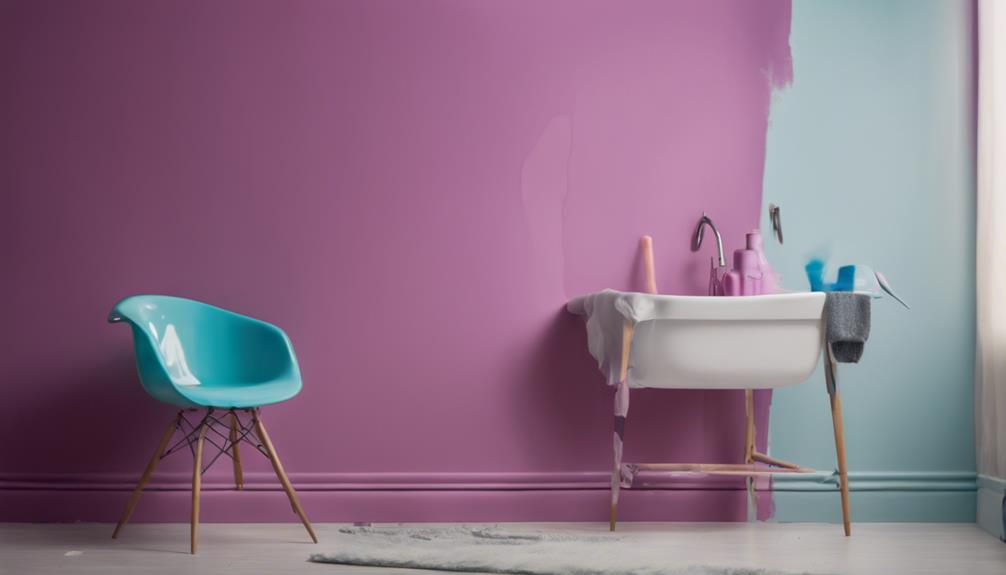
Latex paint, known for its water-based composition, offers easy application and cleanup due to the use of latex resin as a binder. This type of paint is highly versatile, commonly used for both interior and exterior surfaces. One key difference between latex paint and other types, such as oil-based paints, is that latex paint dries relatively quickly. It's a popular choice for many homeowners and professionals due to its low odor and environmental friendliness.
When considering interior paint options, latex paint is a top choice for many. Its acrylic properties make it a durable option for walls and ceilings, providing a smooth finish that's easy to maintain. Additionally, latex paint is known for its excellent adhesion, making it suitable for a wide range of surfaces. For exterior surfaces, latex paint offers good weather resistance, preventing cracking and peeling. Before applying latex paint, it's crucial to establish proper priming for excellent results.
Oil-Based Vs. Latex Paint
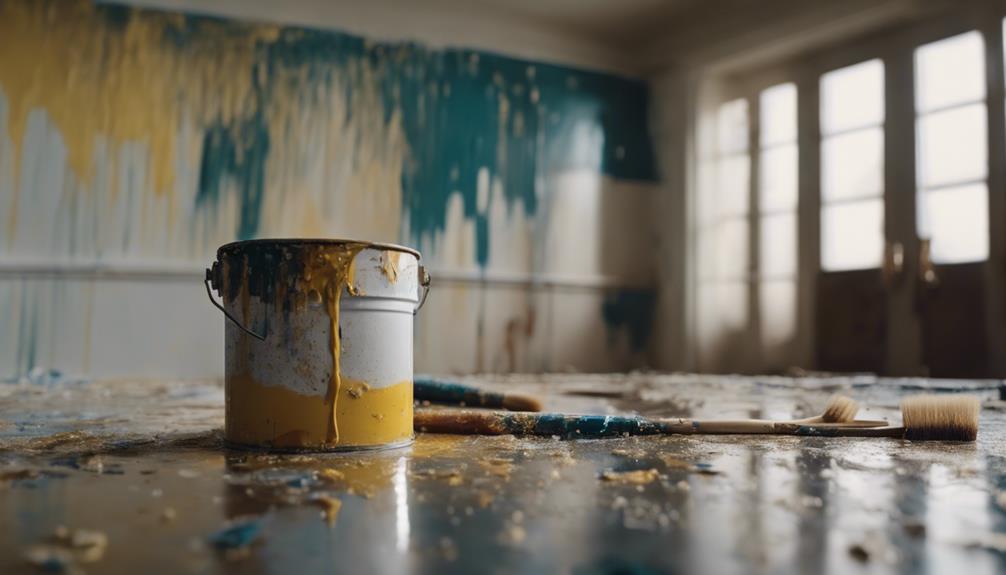
When comparing oil-based paint to latex paint, consider the differences in durability and finish quality.
Oil-based paint is known for its durability, making it ideal for surfaces that endure a lot of wear and tear. It provides a smooth finish that can hide imperfections better than latex paint. However, oil-based paint requires paint thinners for cleanup, which can be more time-consuming and involve harsh chemicals.
On the other hand, latex paint, being water-based, offers easy cleanup with just soap and water, making it a more convenient choice for many. Latex paint is also recommended for larger areas because it's readily available in larger quantities, reducing the need for frequent trips to the store.
While latex paint may not be as durable as oil-based paint, its ease of use and versatility make it a popular option for both residential and commercial painting projects.
Benefits of Latex Interior Paint

Latex interior paint offers you great benefits like durability and an easy cleanup option.
With its water-based formula, cleaning up spills or brushes becomes a breeze.
Plus, latex paint dries quickly, making your painting projects faster and more efficient.
Durability of Latex
For surfaces in your home that require lasting protection and resilience, interior paint made with latex proves to be a durable and reliable choice. Latex paint is known for its good durability on interior surfaces like walls, ceilings, and trim. It resists cracking and peeling, providing a long-lasting finish that can withstand minor impacts and movements without damage.
This flexibility makes latex paint ideal for high-traffic areas, maintaining its appearance over time. With proper application and maintenance, latex interior paint can last for years without significant wear and tear.
Easy Cleanup Option
With its easy cleanup feature, latex interior paint offers a convenient solution for maintaining the longevity and appearance of high-traffic areas in your home. This water-based paint, also known as acrylic paint, allows for effortless cleaning with just soap and water, making it ideal for DIY projects.
The quick drying nature of latex paint not only enables speedy recoating but also reduces exposure to harmful chemicals during application and cleanup. Cleanup of tools like brushes and rollers becomes a hassle-free task, saving you time and effort.
Homeowners often favor latex interior paint for its easy cleanup benefits, making it a popular choice for those seeking a low-maintenance painting option that still delivers excellent results.
Application Tips for Latex Paint
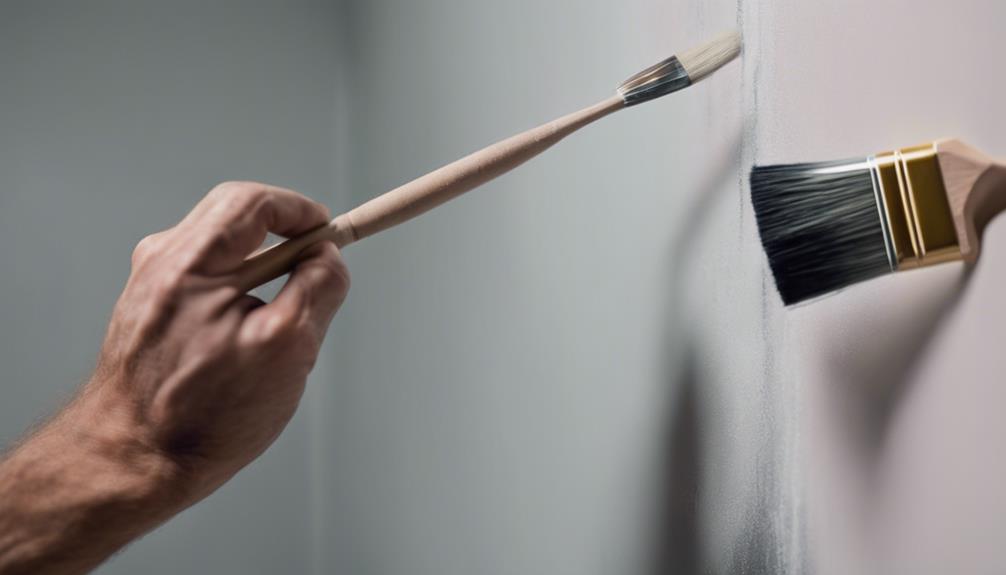
To guarantee a smooth application of interior latex paint, consider starting with proper surface preparation. Latex paint offers versatility in application methods, allowing you to use brushes, rollers, or sprayers for your interior painting projects. Its quick drying time and low odor make it convenient for indoor use.
Additionally, latex paint is environmentally friendly and can be easily cleaned up with soap and water, making it a practical choice. When used on exterior surfaces, latex paint showcases good weather resistance, protecting your walls and ceilings. It also helps prevent cracking and peeling, ensuring a long-lasting finish that withstands the elements.
Durability of Latex Paint
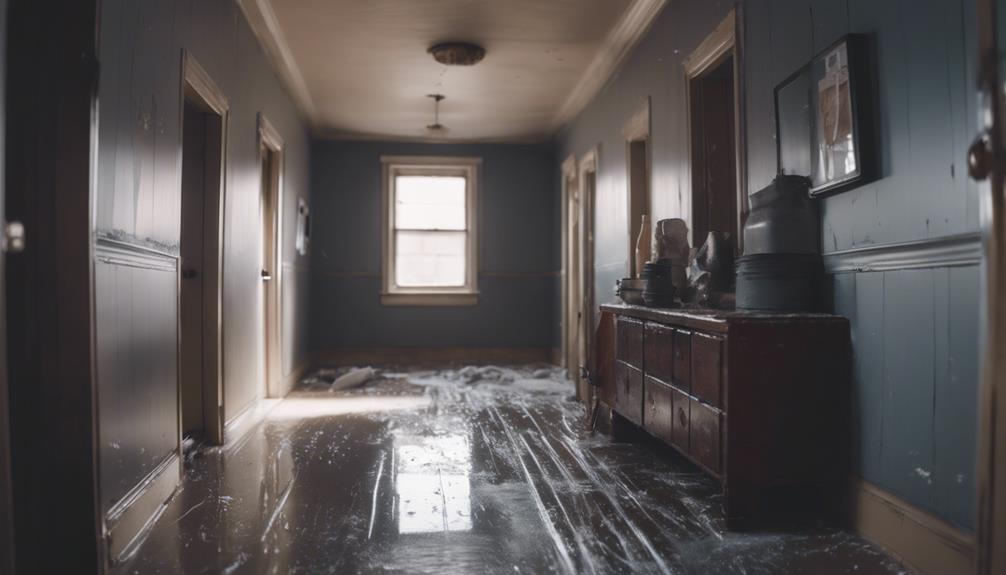
When considering the durability of latex paint for interior surfaces, proper application and maintenance play essential roles in enhancing its longevity. Latex paint offers good durability for walls, ceilings, and trim, as it resists cracking and peeling, providing long-lasting protection. This makes it an ideal choice for high-traffic areas where wear and tear are common.
To maintain the durability of latex paint on interior surfaces, regular cleaning and touch-ups are vital. By addressing any issues promptly, such as small cracks or areas of peeling, you can prevent larger problems from developing and guarantee the paint maintains its protective qualities. Additionally, following the manufacturer's guidelines for application and using high-quality tools can contribute to the paint's durability.
Cleaning Up Latex Paint
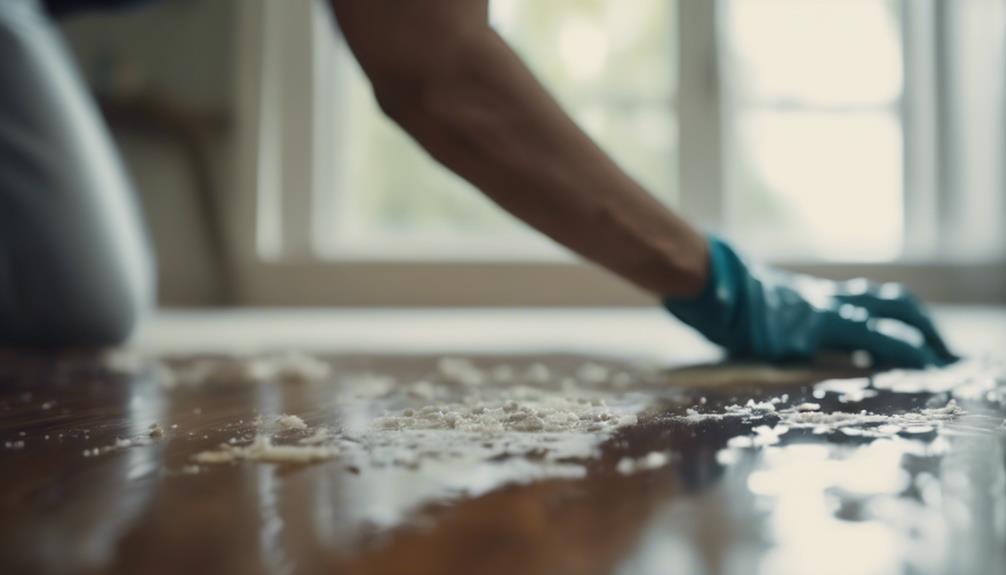
Keeping your interior surfaces clean after using latex paint is a simple task that can be easily accomplished with basic household items. When dealing with fresh latex paint spills, a damp cloth or sponge and some soap and water should do the trick. For dried latex paint, start by scraping off any excess paint using a putty knife before cleaning the area with soap and water. Remember to avoid using harsh chemicals or solvents as they may cause damage to the surfaces. Additionally, be sure to dispose of any latex paint waste properly according to local regulations to protect the environment.
| Cleaning Up Latex Paint | |
|---|---|
| Latex Paint | Soap |
| Interior Paint | Water |
| Cleaning Up | Sponge |
| Dried Latex Paint | Putty Knife |
| Dispose of | Regulations |
Common Uses for Latex Paint

Latex paint finds common use in enhancing the appearance of interior spaces, such as walls, ceilings, and trim work in both residential and commercial settings. This versatile water-based paint is perfect for various surfaces like drywall, plaster, wood, and primed metal. Whether you prefer a matte, satin, or glossy finish, latex paint offers a range of options to match your design needs. One of the key benefits of using latex paint for interior painting projects is its quick drying time, allowing you to complete your project faster with minimal downtime.
Moreover, latex paint is favored for indoor painting due to its low odor and easy cleanup using simple soap and water. So, whether you're looking to freshen up your living room walls or add a pop of color to your office space, latex paint is a reliable choice. Its ease of application and variety of finishes make it a go-to option for transforming your interiors with style and efficiency.
Frequently Asked Questions
Is Regular Interior Paint Latex?
Regular interior paint is indeed latex-based, using latex resin as a binder. This water-based paint is a popular choice for its ease of application, cleanup, and eco-friendly nature. It's versatile, suitable for walls, ceilings, and trim.
With different finishes available, it dries quickly and has a low odor. By using latex paint on interior surfaces, you can prevent cracking and peeling while achieving a durable and appealing finish.
How Can You Tell if Interior Paint Is Latex?
To identify if interior paint is latex, try cleaning a small area with soap and water. If the paint comes off easily, it's likely latex. Latex paints dry fast, have less smell than oil-based ones, and are ideal for walls and ceilings.
Look for labels mentioning latex or water cleanup for clues. These paints are water-based and use latex resin as a binder, making them a popular choice for indoor projects.
Is 100% Acrylic Paint the Same as Latex Paint?
Acrylic paint and latex paint are both water-based, but they differ in resin type. Acrylic paint contains acrylic resin for durability, while latex paint has latex resin. Acrylic paint is more durable for exterior projects, while latex is popular for interior walls due to ease of application.
100% Acrylic paint is considered more durable and long-lasting than latex. Remember, for interior walls, latex is a common choice!
When Not to Use Latex Paint?
When deciding when not to use latex paint, it's important to take into account various factors like surface stability, exposure to water, heat, and existing conditions. Areas prone to peeling, constant moisture, high heat, oil stains, or efflorescence may not be suitable for latex paint.
Special preparation or alternative coatings might be necessary for best results. Understanding these considerations guarantees a successful paint job that stands the test of time.
Conclusion
To sum up, interior paint labeled as 'latex' may not actually contain latex at all! Instead, it refers to the water-based nature of the paint.
This type of paint offers many benefits, such as easy cleanup and durability, making it a popular choice for home projects.
So next time you're painting your walls, remember that 'latex' paint isn't what you think it's – but it's still a great option for a fresh new look in your home!
Interior
How Hard Is Interior Design
Step into the challenging and creative world of interior design where every project is a new puzzle waiting to be solved.
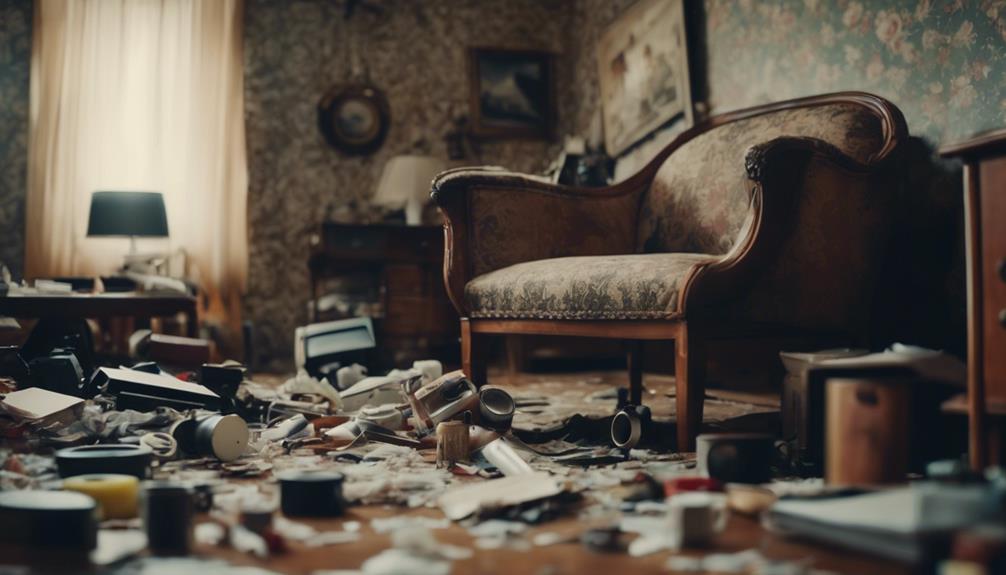
Starting on interior design is like starting on a thrilling adventure! You'll immerse yourself in a world where creativity meets technical know-how, and business skills play an important role. Expect challenges in juggling different styles and managing demanding schedules. Continuous learning is key to success. From mastering client relationships to balancing project requirements, there's always something new to learn. Financial stability can be tricky, but strategies can help. Proficiency in CAD software, space planning, and project management are essential skills. Begin by developing problem-solving skills and building a strong portfolio. Success in interior design is a journey of growth and discovery!
Key Takeaways
- Highly competitive industry with a need to showcase creativity and skills.
- Balancing different design styles and preferences is crucial.
- Continuous learning and adapting to trends are essential.
- Business acumen is key for success in interior design.
- Managing demanding schedules and irregular work hours is a challenge.
Industry Competition and Challenges

Navigating the competitive landscape and overcoming challenges in the interior design industry is crucial. In the world of interior design, competition among design firms is fierce. To stand out, you must showcase your interior design skills, creativity, and ability to exceed client expectations. Juggling client work from various projects adds complexity to your role, requiring you to balance different design styles and preferences simultaneously.
Designers in this industry are constantly challenged to innovate and adapt to the ever-changing trends. Staying ahead means continuous learning and honing your craft. Successful interior designers not only possess a keen eye for aesthetics but also have the business acumen to thrive in this competitive field.
To succeed in the interior design industry, demonstrating your unique approach, attention to detail, and passion for creating stunning spaces is vital. By mastering these skills and delivering exceptional results, you can overcome the challenges and thrive in this dynamic and demanding profession.
Demanding Work Hours

Interior designers often endure long and irregular work hours to meet project deadlines and satisfy client expectations. The experience of interior designers frequently involves late nights and weekends dedicated to ensuring that projects are completed on time. Meeting with clients, conducting site visits, and overseeing installations can further extend their work hours, making the profession demanding in relation to time commitment.
With the need to balance multiple projects simultaneously, interior designers find themselves managing through demanding work schedules. Flexibility and adaptability are essential skills for interior designers to effectively handle the challenges that come with the long and irregular work hours in this field.
Despite the demanding nature of the work hours, many interior designers find fulfillment in creating beautiful spaces and meeting their clients' needs, making the effort worthwhile. So, if you're considering a career in interior design, be prepared to put in the time and effort required to excel in this dynamic industry.
Need for Continuous Learning

Embracing continuous learning in interior design guarantees that professionals remain competitive in a rapidly evolving industry. In the world of design, staying current with trends, technologies, and materials is vital for success.
Continuous learning allows designers to explore new software, techniques, and industry standards that keep them at the cutting edge. By investing in professional development through workshops, seminars, and courses, interior designers can refine their skills, expand their knowledge, and adapt to changing client preferences effectively.
Learning about sustainability, accessibility, and ergonomics is also essential for creating functional and environmentally friendly designs that meet the needs of today's conscious consumers. Making a commitment to continuous learning not only enhances expertise but also ensures relevance in the dynamic field of interior design.
Client Acquisition and Project Management

To excel in interior design, mastering client acquisition and project management is essential. Client acquisition involves showcasing your communication skills, networking abilities, and a solid portfolio to attract potential clients. In a competitive field with diverse client preferences, standing out is vital. Successful interior designers understand the importance of building relationships and effectively conveying their unique style and expertise to secure projects.
Project management in interior design is about juggling various elements like timelines, budgets, and resources to guarantee a smooth process from concept to completion. It requires setting clear goals, establishing timelines, and maintaining open communication channels with clients to deliver projects successfully. Balancing client expectations with project requirements is a critical skill in managing interior design projects. By understanding client needs and preferences while staying true to your design vision, you can create spaces that exceed expectations and leave a lasting impression.
Mastering both client acquisition and project management is essential for a flourishing career in interior design.
Financial Stability Concerns

When considering a career in interior design, it's important to be aware of potential financial challenges. Factors like irregular project timelines and payment schedules can impact your income stability.
Budgeting skills, supplementing income with side projects, and building a strong client base are essential strategies to navigate these fluctuations successfully.
Income Potential Challenges
Exploring the interior design industry can present aspiring professionals with significant challenges in achieving financial stability, particularly in the early stages of their careers. Here are some income potential challenges you might encounter along your career path:
- Building a client base takes time, impacting your financial stability.
- Strategies to boost earnings over time are important for overcoming income challenges.
- The hours required to grow in interior design can affect your financial stability.
- Selling big ideas effectively to clients is essential for improving your income potential.
- Balancing the time investment needed to cultivate a successful career with maintaining financial stability can be a significant challenge.
Navigating these hurdles requires dedication and strategic planning as you progress in the field of interior design.
Budgeting for Freelancers
Managing the challenges of financial stability as a freelancer in interior design involves careful budgeting to account for variable income streams and irregular project timelines. It's important for freelancers to track expenses, plan for taxes, and set aside savings for lean periods in the industry.
Understanding cash flow and managing client payments are essential aspects of budgeting for financial stability. Freelancers should consider setting project-based fees, negotiating contracts, and diversifying their client base to mitigate financial risks.
Creating a detailed budget with clear goals and projections can help freelancers navigate the financial challenges. This approach guarantees you can sustain your Design Studio during fluctuations, leverage your work experience effectively, and thrive in the competitive landscape of interior design businesses.
Job Market Fluctuations
Finding your way through the interior design job market can be challenging due to its tendency to fluctuate based on economic conditions and client demand. Financial stability concerns may arise due to inconsistent project flow and income variability.
Interior designers in the United States may face challenges in securing long-term projects, impacting their financial security within the design field. To navigate these fluctuations, consider strategies like understanding market trends and diversifying services.
Building a strong client base and offering diverse design services can help mitigate financial instability and guarantee a more stable income flow. Stay proactive and adaptable to the market demands to enhance your financial stability in the dynamic world of interior design.
Technical Skills and Experience Requirements

Interior design demands a range of technical skills like CAD proficiency, spatial planning, and material knowledge. Experience plays a crucial role in grasping client requirements, managing projects effectively, and adhering to industry norms.
Overcoming early career challenges, such as acquiring these skills and gaining experience, is essential for aspiring interior designers.
Skills Required
Possessing a blend of technical skills and practical experience is essential for success in interior design. To excel in this field, you need to focus on honing specific skills and gaining valuable experience. Here are some key skills required for interior design:
- Proficiency in CAD software is vital for creating detailed designs.
- Gain experience in space planning to optimize the functionality of different areas.
- Understanding building codes is necessary to guarantee designs meet safety regulations.
- Join a mentorship program to learn from experienced professionals in the industry.
- Develop skills in drafting, rendering, and project management to handle diverse design projects effectively.
Experience Level
Acquiring a diverse set of technical skills and accumulating practical experience is crucial for successfully maneuvering through the challenges of interior design. Whether you're considering enrolling in one of the best interior design schools, pursuing interior design certification, or simply dreaming of becoming an interior designer, honing your craft is key.
Entry into the field can be competitive, with employers often looking for candidates proficient in CAD software and experienced in project management. Without prior work experience, landing a job as an entry-level interior designer may pose challenges. To overcome this hurdle, focus on building a strong portfolio that showcases your technical skills and project management capabilities.
Path to Success in Interior Design

Starting on the journey to success in interior design requires unwavering dedication and a thirst for continuous learning. To pave your way to becoming a successful interior designer, consider the following tips:
- Develop Your Problem-Solving Skills: Interior design is all about creativity and finding solutions. Whether you're redesigning a small apartment in New York or a spacious home in the suburbs, the ability to solve problems creatively will set you apart.
- Seek Mentorship Opportunities: Learning from experienced professionals can provide valuable insights and guidance on maneuvering the industry. Don't hesitate to reach out to established designers for advice and mentorship.
- Stay Updated on Industry Trends: The world of interior design is constantly evolving. Keeping up with the latest trends, materials, and technologies will help you stay relevant and innovative in your designs.
- Build a Strong Portfolio: Showcase your best work through a well-curated portfolio. Highlighting your unique style and creativity will attract potential clients and set you apart from the competition.
- Network and Collaborate: Building strong relationships within the industry can open doors to new opportunities. Collaborating with other designers, architects, and industry professionals can lead to exciting projects and growth in your career.
Frequently Asked Questions
Is Interior Design Hard to Learn?
Interior design can be challenging to learn, especially without prior experience or formal education. Understanding technical skills like CAD software and design principles adds complexity. Building codes and safety standards further increase the learning curve.
Creativity, planning, and material knowledge are all essential aspects. Continuous learning and staying updated on trends are crucial for success. With dedication and practice, you can navigate the complexities of interior design and thrive in this multifaceted field.
Is Being an Interior Designer Hard?
Being an interior designer can be challenging but rewarding. It involves creativity, client communication, project management, and staying updated on design trends.
Overcoming obstacles like acquiring clients and ensuring financial stability are part of the journey. However, with passion, dedication, and continuous learning, you can thrive in this competitive field.
Success in interior design is more about perseverance and honing your skills rather than relying solely on talent. Embrace the challenges and enjoy the journey!
Is Interior Design a Hard Skill?
Interior design encompasses a variety of skills, from technical know-how to creative problem-solving. Managing tasks like client communication and project timelines requires multitasking abilities. Staying updated on trends and technologies is key to delivering innovative designs.
While challenging, success in interior design is achievable with dedication and passion. By mastering these skills and staying current in the field, you can navigate the complexities and create exceptional designs that stand out.
Is Interior Design a Lot of Math?
Interior design involves a fair amount of math. You'll use fractions, ratios, and geometry to measure rooms, plan spaces, and select furniture sizes. Understanding scale and balance is key for creating harmonious designs.
Luckily, there are software tools to help with complex calculations. So, while math is definitely part of interior design, it can also be a fun and rewarding aspect of the creative process.
Conclusion
To sum up, interior design can be challenging but rewarding. By staying dedicated, continuously learning, and honing your skills, you can navigate the competitive industry and achieve success.
With hard work, perseverance, and a passion for design, you can overcome the obstacles and thrive in this dynamic field. Remember, success in interior design isn't just about talent, but also about determination and a drive to constantly improve.
Embrace the journey and enjoy the process!
Interior
How Big Is a Standard Interior Door
Peek into the dimensions of a standard interior door, unlocking the secrets to fitting it perfectly in your home.

Standard interior doors are typically about 80 inches tall and vary in width from 24 to 36 inches, with a thickness of around 1 3/8 inches. These door sizes comply with residential codes and fit snugly into most door frames. The door jamb, which frames the door, is usually 4 9/16 inches wide by 6 9/16 inches tall. When preparing the rough opening for the door frame, remember to make it 2 inches wider and taller than the door size for installation ease. Oversized interior doors can reach heights of 84 to 96 inches, providing a touch of luxury and grandeur to any space.
Key Takeaways
- Standard interior doors are typically 80 inches tall.
- Widths range from 24 to 36 inches.
- Compliance with International Residential Code ensures uniformity.
- Door frames are 80 inches tall by 36 inches wide.
- Door jambs are typically 4 9/16 inches wide by 6 9/16 inches tall.
Standard Interior Door Dimensions
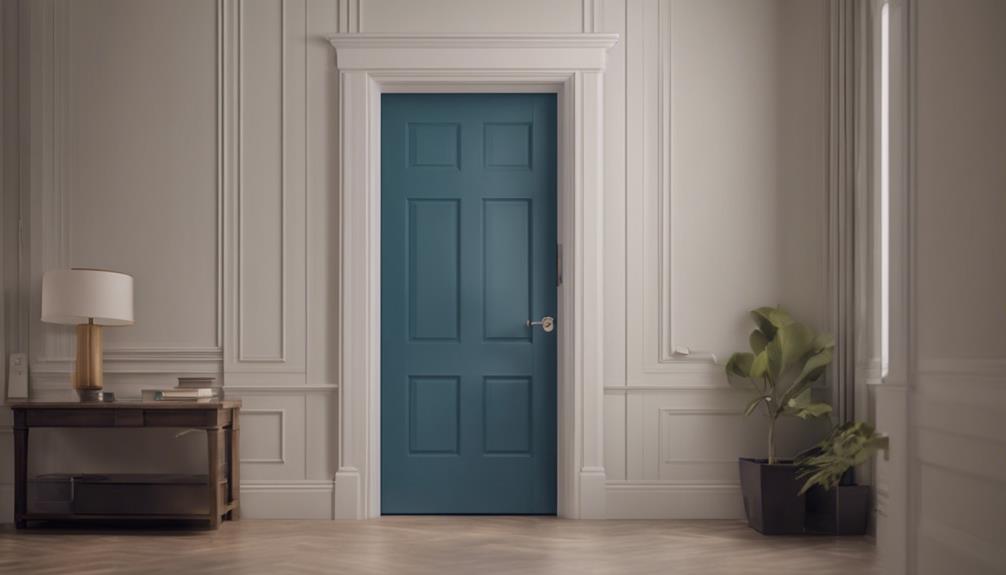
When selecting a standard interior door size, keep in mind that they're typically 80 inches tall and come in widths ranging from 24 to 36 inches. The standard thickness for these doors is 1 3/8 inches. This standard sizing guarantees that interior doors fit seamlessly into most residential buildings, meeting the requirements set by the International Residential Code.
Standard interior doors, with a height of 80 inches, are designed to accommodate the majority of door frames found in homes. The range of widths from 24 to 36 inches offers versatility in fitting different openings while maintaining a cohesive look throughout the house. The standard thickness of 1 3/8 inches strikes a balance between sturdiness and weight, making these doors easy to handle and install.
Whether you're renovating or building a new home, knowing the standard dimensions of interior doors can help you plan effectively and ensure a smooth installation process. These measurements provide a solid foundation for selecting the right doors that will enhance both the functionality and aesthetics of your living space.
Height and Width of Interior Doors
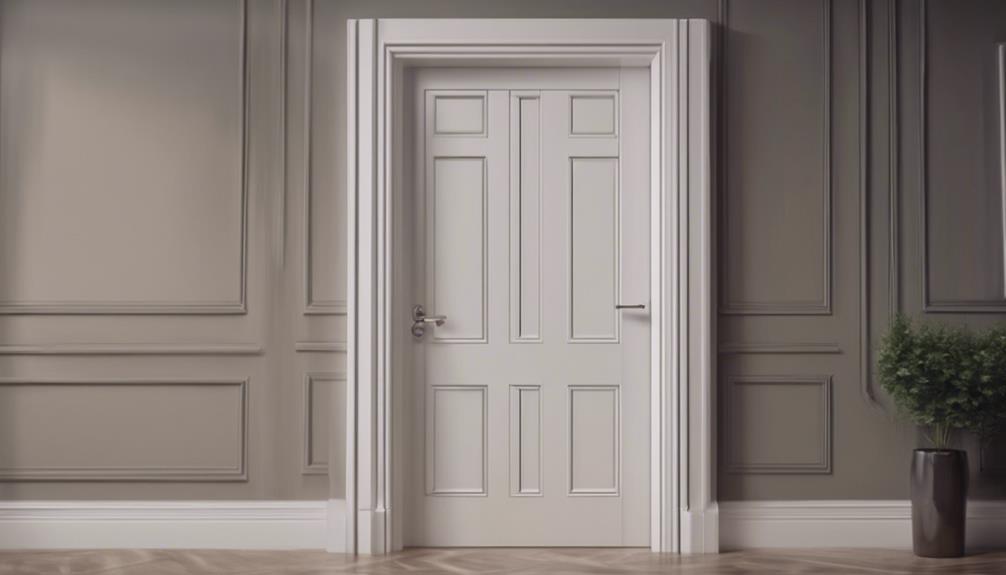
When considering the standard dimensions for interior doors, it's important to understand the typical height and width specifications commonly found in residential buildings. Standard interior doors are usually 80 inches tall, making sure they provide adequate clearance for most individuals. The widths of these doors can vary, with common measurements falling between 24 to 36 inches wide. This range allows for flexibility in design and functionality, accommodating different needs within a home.
The 1 3/8-inch thickness of interior doors strikes a balance between sturdiness and practicality, fitting well within most door frames. Keep in mind that the minimum height for passage doors is set at 80 inches to comply with regulations and ensure accessibility. Additionally, the International Residential Code may specify particular height and width requirements for interior doors to meet safety standards and building codes. Understanding these standard dimensions will help you choose the right interior doors for your home, making sure they fit properly and function effectively.
Typical Door Jamb Size
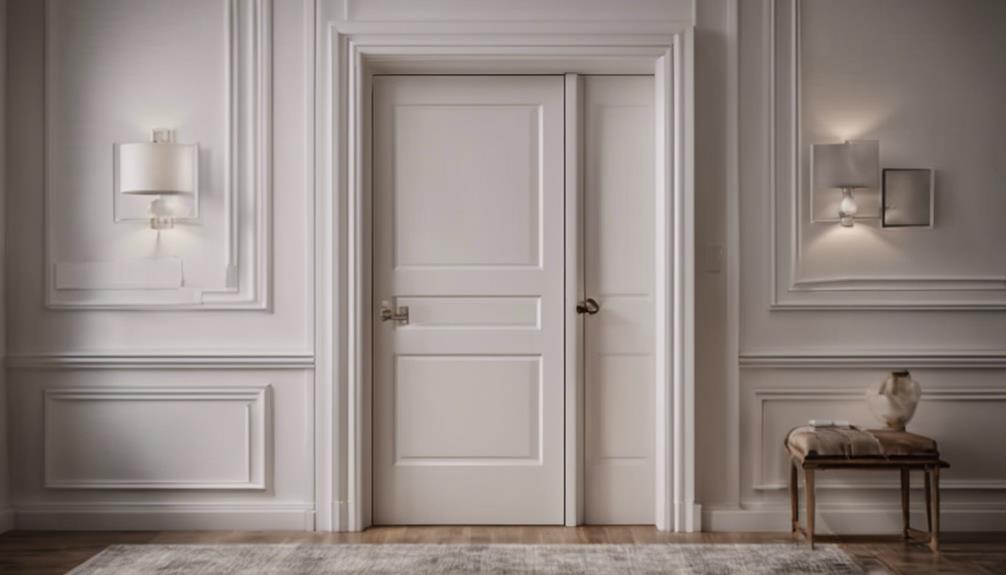
When it comes to the typical door jamb size, it's important to take into account the door frame dimensions, standard door width, and jamb material options. Understanding these aspects will help you select the right door for your space and guarantee a proper fit.
The door jamb provides the framework for your door installation, so knowing its size is crucial for a successful project.
Door Frame Dimensions
To ensure a proper fit for a standard interior door installation, understanding the typical door jamb size, which is 4 9/16 inches wide by 6 9/16 inches tall, is essential. When it comes to door frames for standard interior doors, the typical size needed is 80 inches tall by 36 inches wide, with a rough opening requirement of approximately 82 inches tall by 38 inches wide. Making sure your door frame dimensions align with these standards is vital for a successful installation. Below is a table summarizing these door frame dimensions:
| Aspect | Measurement |
|---|---|
| Door Jamb Width | 4 9/16 inches |
| Door Jamb Height | 6 9/16 inches |
| Frame Height (Standard) | 80 inches |
| Frame Width (Standard) | 36 inches |
Standard Door Width
If you want to guarantee that your standard interior door fits correctly, understanding the typical door jamb size is key, with door widths ranging from 28 to 32 inches.
Here are some important facts about standard door width and interior doors:
- Most interior doors have a width ranging from 28 to 32 inches.
- Door jambs for interior doors are typically 4 9/16 inches wide by 6 9/16 inches tall.
- Taller interior doors are considered oversized and may have custom dimensions.
- The rough opening for a standard interior door is usually 82 inches by 38 inches.
Knowing these standard sizing details will help you choose the right interior door for your space.
Jamb Material Options
For essential door frame stability and support, selecting the right jamb material is vital. You can choose from various options like wood, composite, PVC, or aluminum for your door jamb. The typical door jamb size is 4 9/16 inches wide by 6 9/16 inches tall.
These jamb materials play a pivotal role as structural components that support the door frame, influencing its overall strength and stability. Proper installation of the door jamb is key to guarantee your door functions correctly. Whether you opt for the traditional warmth of wood or the durability of aluminum, the jamb material you select will impact the longevity and performance of your door frame.
Consider your preferences and the specific needs of your space when choosing the right door jamb material.
Rough Opening for Door Frame
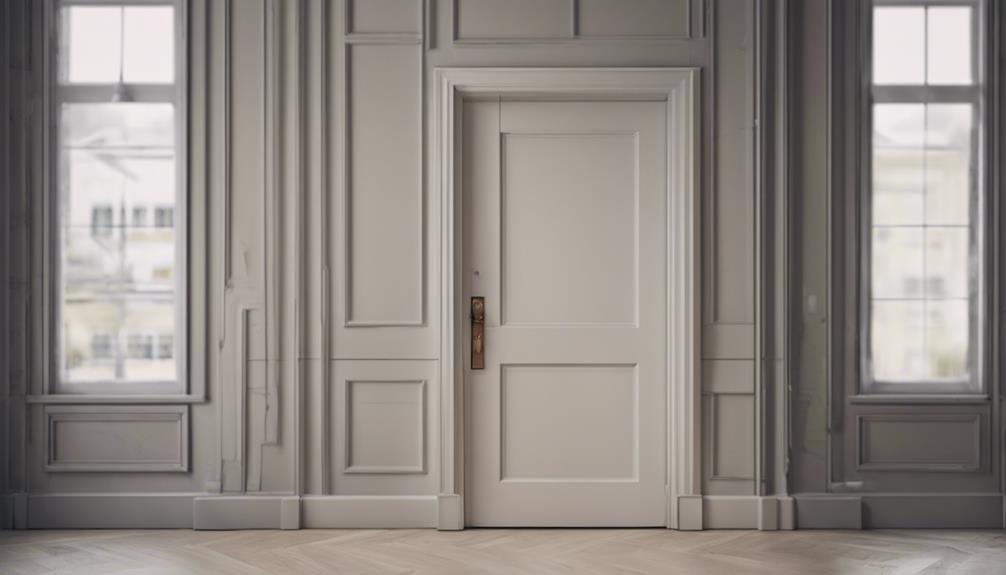
When framing a standard interior door, make sure the rough opening is 2 inches wider and 2 inches taller than the door size. This guarantees a proper fit and allows for adjustments during installation.
Here are some key points to keep in mind:
- Provide Adequate Space: The extra 2 inches in width and height around the actual door size create room for adjustments and shimming, making installation easier.
- Prevent Issues: Proper measurements for the interior door rough opening help prevent alignment problems and ensure the door fits correctly within the frame.
- Ensure Stability: A well-sized rough opening contributes to the stability of the door frame, preventing it from shifting or becoming misaligned over time.
- Facilitate Installation: Having the correct rough opening dimensions simplifies the installation process, leading to a smoother and more efficient door hanging experience.
Oversized Interior Doors
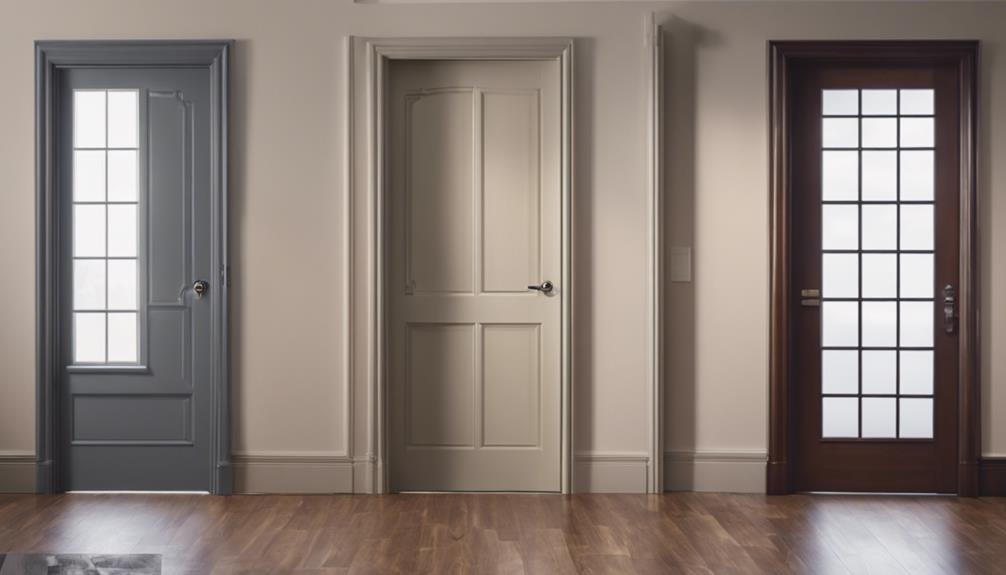
Exploring oversized interior doors brings a touch of grandeur to your living space, extending beyond the conventional height and width standards. These doors typically surpass the standard 80-inch height, ranging from 84 to 96 inches to cater to higher ceilings, creating a more open and spacious feel. In addition to height, the width of oversized interior doors can exceed the standard 36 inches, offering a grand entrance to your rooms. Custom sizes for these doors provide a unique opportunity to address special framing considerations for a proper and secure fit, allowing you to tailor the design to fit larger spaces perfectly and add a personalized touch to your home decor.
When considering oversized interior doors, it's important to note that their installation may necessitate special framing considerations to ensure a proper and secure fit. By opting for these larger doors, you can make a bold statement in your home while enhancing the overall aesthetic appeal. Whether you seek to create a grand entrance or add a touch of luxury to your interiors, oversized interior doors can be a stunning choice for your living space.
Common Interior Door Widths

Ranging from 24 to 36 inches, common interior door widths provide a variety of options for standard door sizes in residential spaces. Here are some key points to keep in mind when examining interior door widths:
- Standard Widths: The most common interior door widths you'll encounter are 28, 30, 32, and 36 inches. These sizes are widely used in many homes and offer a good balance between functionality and space efficiency.
- Custom Interior Door Sizes: If you have specific requirements or unique spaces, custom interior door sizes can be tailored to fit your needs. From narrower doors for closets to wider ones for grand entrances, customization allows for a perfect fit in any situation.
- Accessibility: Bear in mind that the minimum width requirement for disability access is typically 36 inches. Making sure that your interior doors meet accessibility standards is important for creating an inclusive living environment.
- Regulations: The International Residential Code sets standards for minimum width requirements for interior doors to guarantee safety and accessibility in residential buildings. Always check local regulations to confirm compliance with these standards.
Frequently Asked Questions
What Are Standard Interior Door Sizes?
Standard interior door sizes typically range from 24 to 36 inches wide and 80 inches tall. Common widths are 28, 30, 32, and 36 inches. Doors are usually 1 3/8 inches thick, or 1 3/4 inches for taller ones.
The minimum height for passage doors is 80 inches, but codes may allow for 78-inch doors. These doors are essential for dividing rooms and come in various sizes to fit different spaces in your home.
Are Most Doors 32 or 36 Inches?
Most interior doors in homes measure either 32 or 36 inches wide. This choice often depends on available space and personal preference.
In older homes, 32-inch doors are more common, while newer constructions often feature 36-inch doors. Despite the width difference, both sizes typically have a standard height of 80 inches.
The decision between 32 and 36-inch doors ultimately comes down to both design aesthetics and practicality in your living space.
What Is the Rough Opening for an Interior Door?
When planning for an interior door, remember that the rough opening, which is slightly larger than the door itself, is key.
For a standard 36-inch door, aim for a rough opening around 38 inches wide and 82 inches tall. These extra inches provide space for the door frame and allow for adjustments during installation.
Ensuring your rough opening is just right will result in a smooth and proper fit for your interior door.
How Wide to Frame a 36 Inch Door?
When framing a 36-inch door, make sure the rough opening width is 38 inches. This extra space accommodates the door frame and shimming for installation.
A 36-inch door needs a 2-inch wider opening to fit correctly. Proper dimensions are important for secure fitting and functionality.
Consider the door swing and clearance requirements when framing. Remember, a little extra space goes a long way in making sure your door fits smoothly and operates perfectly.
Conclusion
So, when it comes to standard interior doors, size does matter! Remember, the typical dimensions for interior doors are around 80 inches tall and 28-32 inches wide.
But don't worry, there's always room for flexibility with oversized options available. As they say, when one door closes, another one opens – make sure it's the right size for your space!
Interior
Can You Use Interior Door for Exterior
Intrigued about using an interior door for exterior? Discover why it's crucial to choose the right door for enhanced safety and durability.
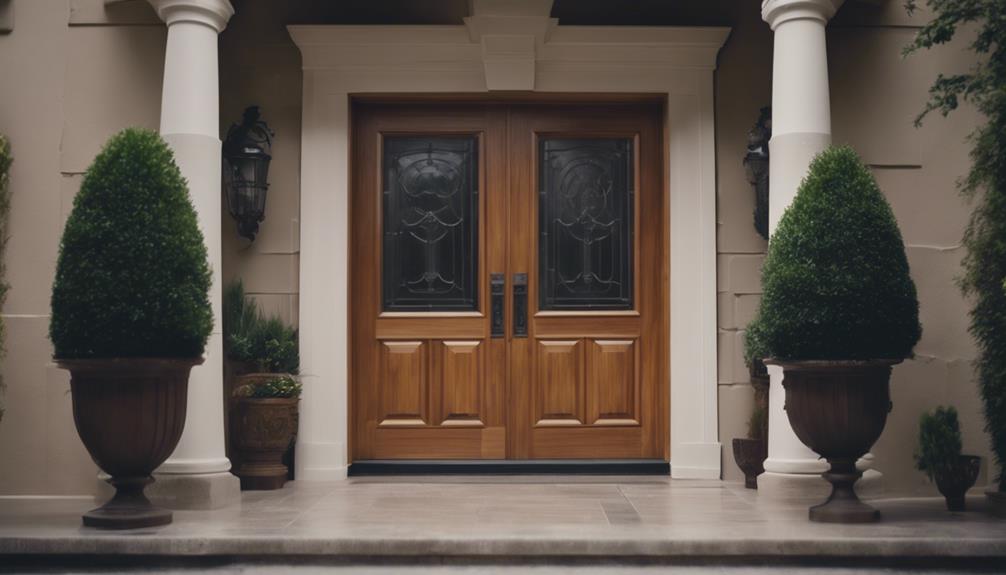
Using an interior door for exterior can compromise safety and expose your door to weather damage. Exterior doors provide enhanced security with durability against harsh elements, unlike interior doors that lack weather-resistant features. Exterior doors are crafted with materials that combat challenges like moisture and sunlight effectively. They offer superior longevity and sturdier construction to handle outdoor conditions. Opting for doors specifically designed for exterior use guarantees better performance over time. Remember, the right exterior door not only boosts your home's security but also protects against weather damage. Further tips await on the benefits of using suitable doors for different areas of your home.
Key Takeaways
- Interior doors lack weather-resistant features for exterior conditions.
- Exterior doors offer enhanced security and durability against outdoor elements.
- Using interior doors outside can compromise safety, insulation, and longevity.
- Exterior doors are specifically designed to withstand harsh weather conditions.
- Opting for exterior doors ensures better protection and longevity for external use.
Exterior Vs. Interior Door Differences
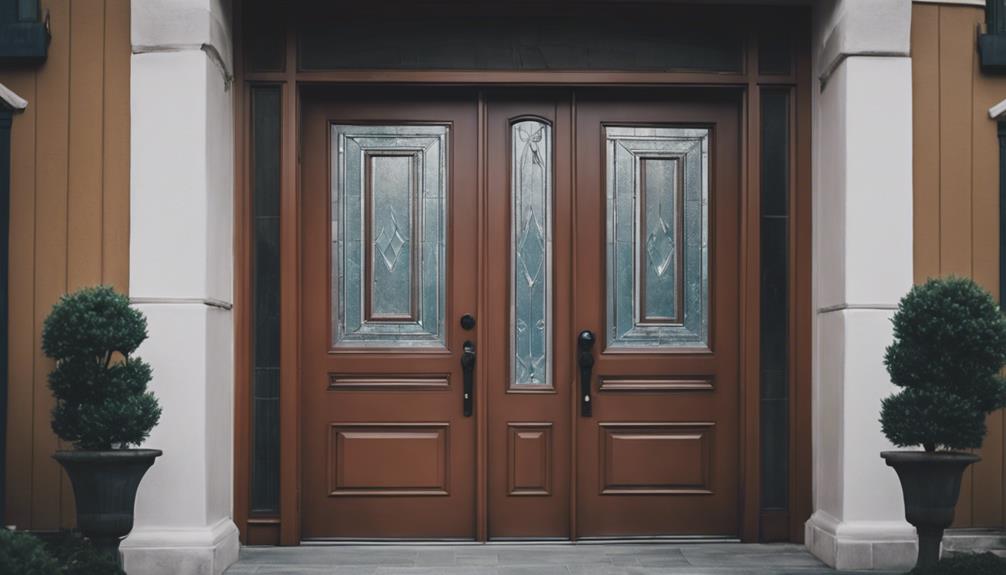
When comparing exterior doors to interior doors, the key differences lie in their construction and materials used. Exterior doors are designed with heavier frames and stronger glass to provide enhanced security and protection from external elements. These doors are made with more insulative and weather-resistant materials to withstand harsh weather conditions.
On the other hand, interior doors don't have the same durability and security features as exterior doors. They aren't equipped to handle the challenges posed by outdoor environments.
Using an interior door as an exterior door can compromise safety and lead to weather damage inside the home. Interior doors lack the necessary strength and weatherproofing to protect your home effectively from external elements like rain, wind, and extreme temperatures.
It's crucial to understand the distinct purposes that exterior and interior doors serve to safeguard the safety and security of your home. By using the appropriate door for each specific function, you can maintain the integrity of your home and enhance its overall protection.
Weather Resistance Considerations
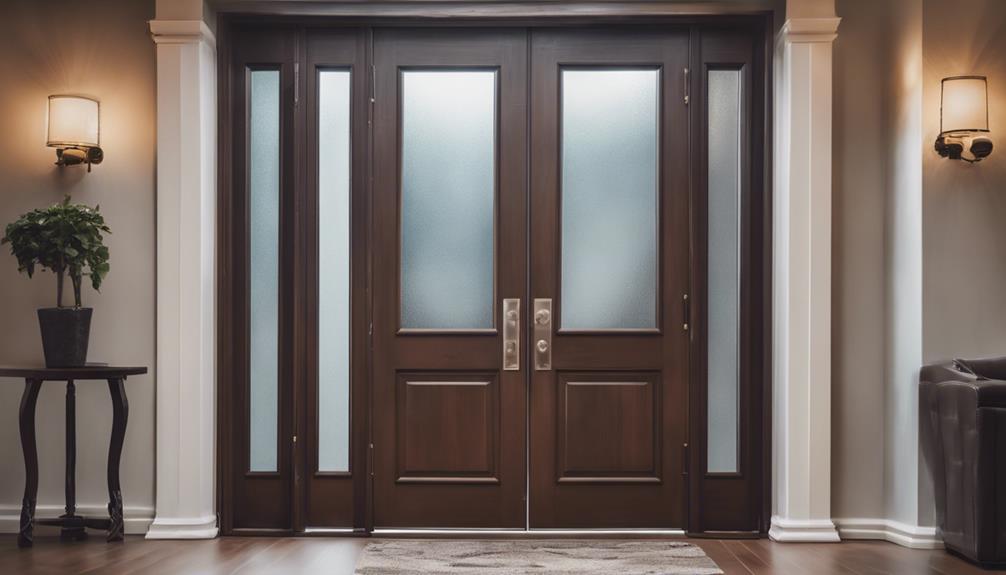
Considering the weather resistance of doors is vital for ensuring their longevity and performance against external elements. When contemplating using interior doors for exterior purposes, it's important to understand that interior doors lack the necessary weather-resistant features required to withstand outdoor conditions. Unlike exterior doors designed specifically to endure harsh weather, interior doors are more susceptible to damage from elements like rain, snow, and sunlight.
Using an interior door outside can lead to issues such as warping, rotting, and decreased durability over time due to exposure to varying weather conditions. Weather exposure can greatly accelerate the deterioration of interior doors when used externally, compromising their functionality and appearance.
In contrast, properly sealed exterior doors are equipped with materials and finishes that provide protection against weather elements, ensuring their longevity and performance over time. Hence, for durability and performance, it's important to select doors that are specifically designed for exterior use to withstand various weather challenges.
Material Suitability for Outdoor Use
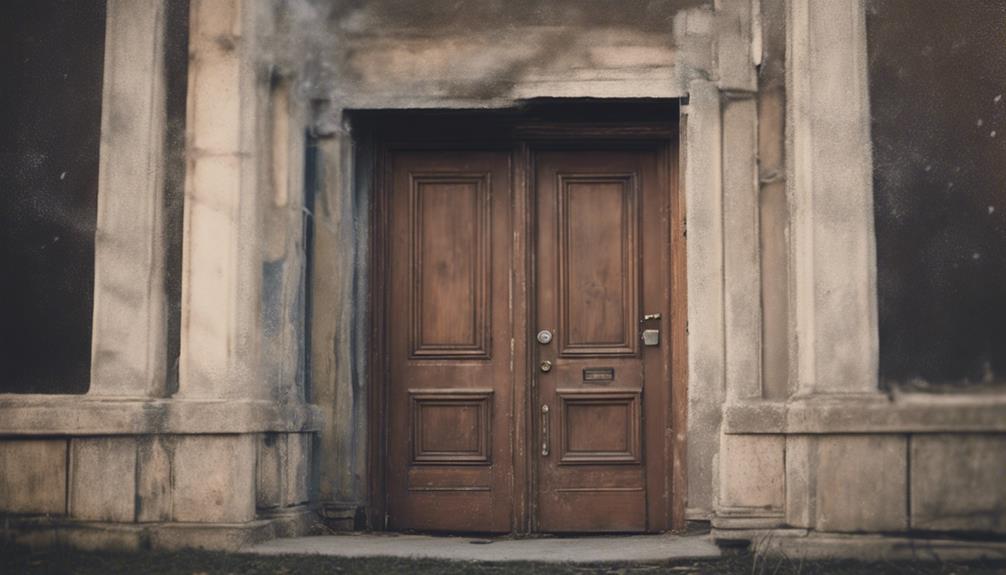
When considering using an interior door for exterior purposes, it's important to assess the material's suitability for outdoor use. Material durability, weather resistance, and longevity expectations are key points to evaluate.
Ensuring the door can withstand elements like rain, wind, and sun exposure is essential for its performance and longevity outdoors.
Material Durability
For exterior applications, guaranteeing the material durability of a door is essential to withstand outdoor elements effectively. While interior doors lack the robust construction needed to endure weather conditions, exterior doors are specifically crafted to combat these challenges.
Materials like fiberglass, steel, or solid wood with appropriate finishes make exterior doors weather-resistant and durable. On the contrary, interior doors may warp, rot, or deteriorate when exposed to moisture, sunlight, and temperature fluctuations, rendering them unsuitable for outdoor use.
The insulation, weather-stripping, and security features found in exterior doors are important for energy efficiency and safety, aspects that interior doors may lack. Selecting the right door material and finish is critical to ensure longevity and performance if considering repurposing an interior door for exterior purposes.
Weather Resistance
To guarantee the suitability of a door for outdoor use, especially regarding weather resistance, the material choice is essential for enduring harsh elements effectively. When considering using a door outside, keep these points in mind:
- Exterior doors are specifically designed to withstand harsh weather conditions.
- Interior door materials may not be weather-resistant, leading to potential damage.
- Exposure to outdoor elements can cause warping, rotting, and deterioration in interior doors.
- Using interior doors outside can compromise their longevity and structural integrity.
- For best weather resistance, it's recommended to use exterior doors designed for outdoor use.
Ensure your door can withstand the elements to avoid issues down the line.
Longevity Expectations
Choosing a door specifically designed for exterior use guarantees longevity and durability in outdoor conditions. When considering entry doors, it's important to prioritize materials that can withstand various weather elements. Here is a comparison between interior and exterior doors regarding longevity expectations:
| Aspect | Interior Doors | Exterior Doors |
|---|---|---|
| Material | Typically not weather-resistant materials | Constructed with weather-resistant materials |
| Durability | Prone to quicker deterioration outdoors | Designed to withstand outdoor elements |
| Performance | Susceptible to warping, rotting, and damage | Ensures longer durability and performance |
To make sure your door lasts in outdoor conditions, choosing an exterior door specifically crafted for the task is important.
Potential Damage Risks
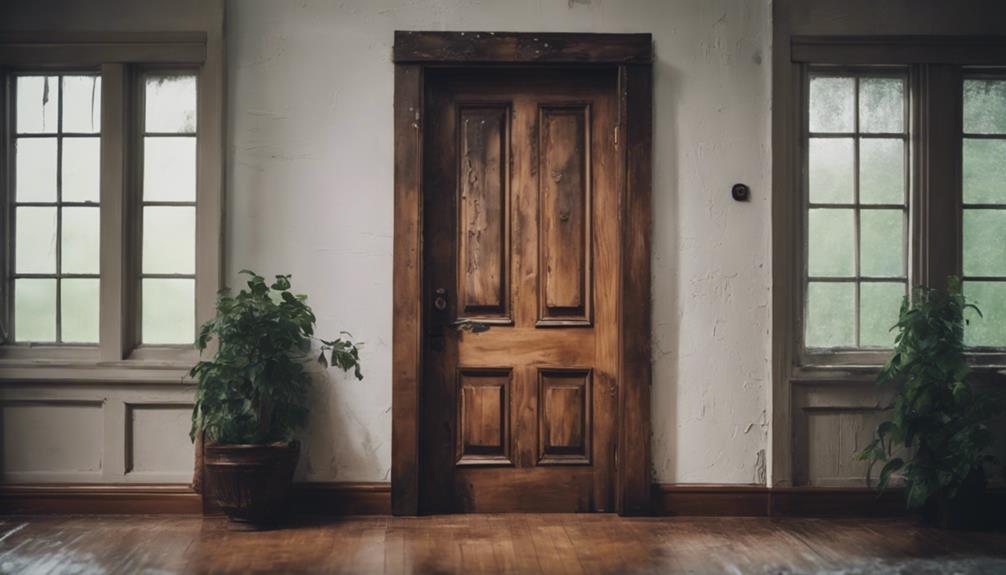
Using an interior door for exterior purposes may expose it to harsh weather conditions, increasing the risk of damage. Interior doors lack the weather resistance needed to withstand elements like rain and sunlight, potentially leading to warping and deterioration.
Additionally, security and durability issues may arise, affecting the door's longevity and potentially impacting warranty coverage.
Weather Resistance Concerns
Exposed to outdoor elements, interior doors are prone to warping, rotting, and decreased durability, making them unsuitable for exterior use. When considering using interior doors outside, you should be aware of the following concerns:
- Exterior doors are designed to withstand harsh weather conditions, unlike interior doors.
- Interior doors may experience warping, rotting, and decreased durability when exposed to outdoor elements.
- Using an interior door for exterior purposes can compromise security and insulation.
- Weather exposure can lead to the voiding of warranties on interior doors used externally.
- Interior doors lack the necessary weather-stripping and materials for long-term outdoor use.
It's crucial to prioritize the longevity and functionality of your doors by selecting the appropriate type for each specific purpose.
Security and Durability Issues
When considering exterior applications for interior doors, it's important to understand the security and durability issues that may arise, particularly concerning potential damage risks.
Interior doors lack the necessary durability and security features to function effectively as exterior doors. Exposure to harsh weather conditions can cause these doors to warp, rot, and deteriorate quickly when used outside. This compromises the security of your home, as interior doors aren't designed to withstand intrusion attempts.
Additionally, the reduced insulation properties of interior doors can lead to energy inefficiency and discomfort in your living space. To avoid these problems, it's essential to invest in doors specifically designed for exterior use to guarantee the safety, durability, and energy efficiency of your home.
Impact on Warranty Coverage
Considering the impact on warranty coverage, utilizing an interior door for exterior purposes can result in voided manufacturer warranties and increased risk of damage like warping and decreased durability.
- Using an interior door for exterior purposes can void manufacturer warranties due to improper usage.
- Exterior exposure can lead to potential damage risks like warping, rotting, and decreased durability.
- Insufficient weather resistance of interior doors can result in compromised structural integrity over time.
- Interior doors lack the necessary features to withstand harsh outdoor conditions, impacting warranty coverage.
- Manufacturers design exterior doors specifically to endure weather elements and provide security, unlike interior doors.
Security and Safety Concerns
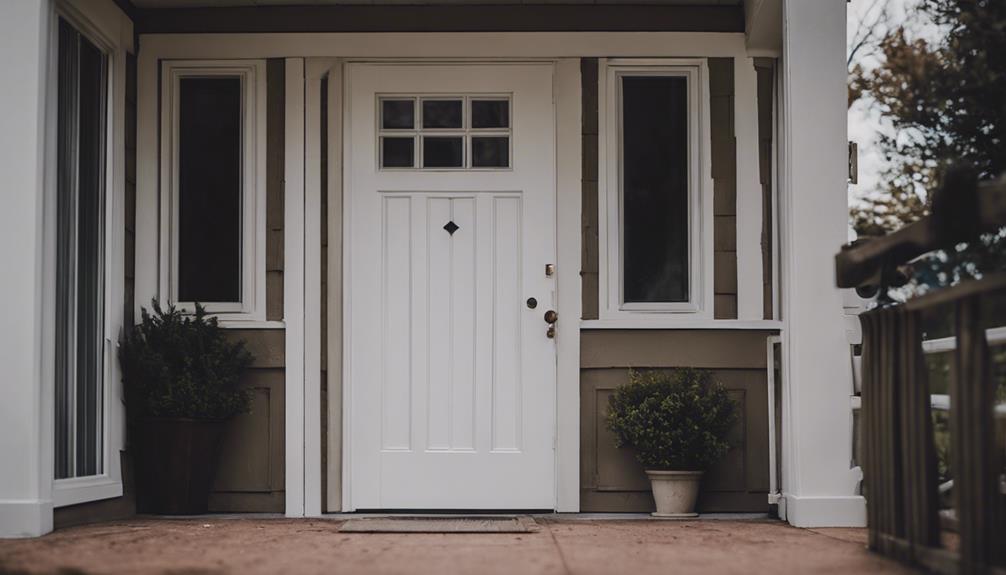
Interior doors used outside pose serious security and safety risks due to their lack of built-in protective features designed for external use. Safety concerns arise when considering the use of interior doors for exterior purposes, as these doors don't offer the same security features as exterior doors. Exterior doors are specifically designed to provide better protection against intruders due to their sturdier construction and enhanced security features. In contrast, interior doors may not have the necessary security measures to withstand external threats, compromising the safety of your property and loved ones.
When it comes to security and safety, choosing the right type of door is important. Exterior doors are equipped with features like robust locks, heavy-duty materials, and weatherproofing to withstand external elements. By using interior doors outside, you risk exposing your home to potential security breaches and safety hazards. It's vital to prioritize security by selecting doors that are specifically designed for exterior use to guarantee the safety of your property and the people within it.
Longevity and Durability Factors

Using an interior door outside exposes it to elements that can greatly impact its longevity and durability. When considering the longevity and durability factors of using interior doors for exterior purposes, it's important to understand the differences between exterior and interior doors:
- Exterior Doors: Specifically designed to withstand harsh weather conditions, offering superior longevity and durability.
- Interior Doors: Lack the weather-resistant features required for prolonged outdoor use, leading to quicker deterioration.
- Material and Construction: Exterior doors are optimized with weather-resistant materials and sturdy construction, ensuring resilience against elements like rain, sun, and temperature changes.
- Deterioration Risk: Using interior doors outside increases the risk of damage and reduces their overall lifespan.
- Optimal Choice: Opting for an exterior door guarantees better longevity and durability due to its weather-resistant design and materials.
When it comes to exterior doors, prioritizing their unique features and durability is important for withstanding outdoor elements effectively.
Cost Comparison: Interior Vs. Exterior
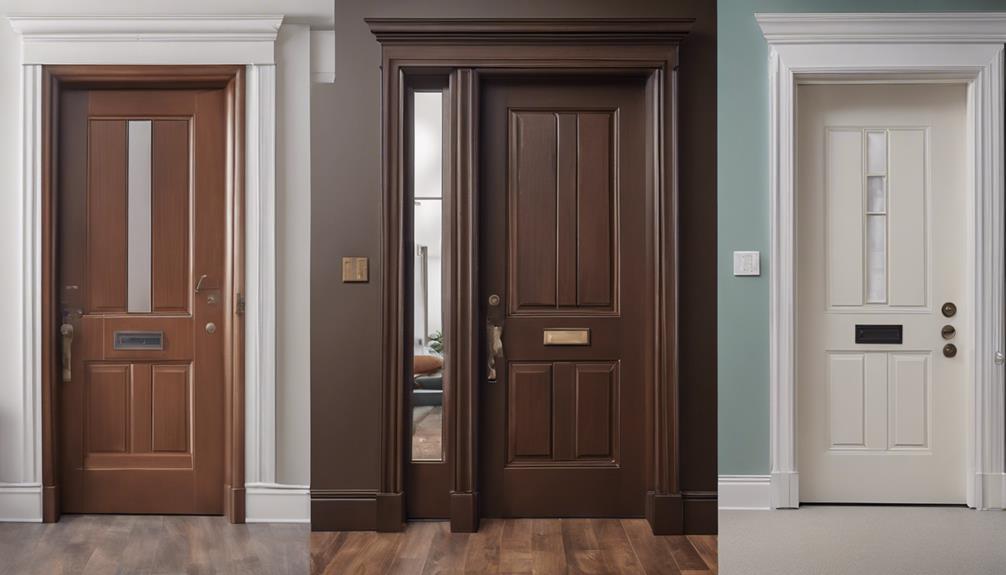
When evaluating costs, interior doors typically offer a more budget-friendly option compared to exterior doors. Interior doors are generally cheaper because they are designed for inside use and do not require the same level of durability and weather resistance as exterior doors. However, exterior doors, while more expensive, provide enhanced security, insulation, and longevity due to their construction with high-quality materials. Here is a comparison between interior and exterior doors:
| Aspect | Interior Doors | Exterior Doors |
|---|---|---|
| Price Range | Lower | Higher |
| Material Quality | Standard | High-quality |
| Durability | Lower | Higher |
Choosing between interior and exterior doors ultimately depends on your specific needs and budget. While interior doors may be a cost-effective solution for certain projects, investing in an exterior door can bring added benefits regarding security and longevity.
Expert Recommendations and Alternatives
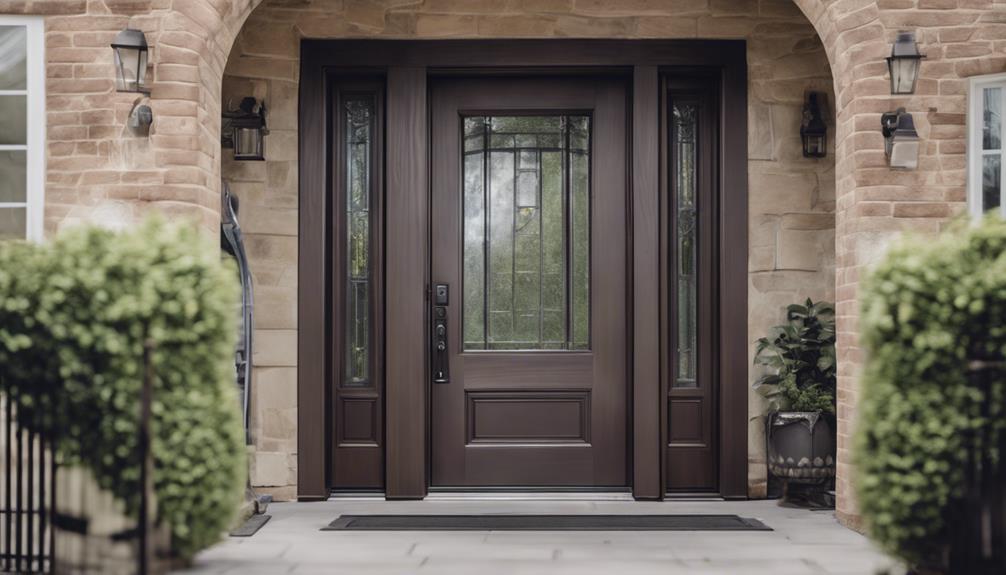
For peak functionality and safety, experts strongly advise against repurposing interior doors for exterior use. When it comes to front doors, using the right type is essential for your home's security and durability. Here are some expert recommendations and alternatives to ponder:
- Durability Concerns: Interior doors lack the necessary durability and weather resistance for exterior use.
- Weather Resistance: Exterior doors are designed to withstand outdoor conditions and provide better insulation.
- Security: Choosing appropriate front doors enhances your home security and guarantees your peace of mind.
- Alternatives: Instead of using interior doors outside, consider reinforcing them or seeking advice from professionals.
- Longevity: Making informed decisions based on expert advice ensures the safety and longevity of your exterior doors.
Frequently Asked Questions
Can a Solid Core Interior Door Be Used as an Exterior Door?
You shouldn't use a solid core interior door as an exterior door. Exterior doors need more durability, weather resistance, and security features than interior doors. Solid core interior doors may warp, rot, and reduce energy efficiency when used outside.
It's important to choose a proper exterior door designed to withstand outdoor conditions and provide insulation. Consulting professionals for the right exterior door guarantees security, durability, and weather protection for your home.
Is There a Difference Between Interior and Exterior Doors?
Yes, there's indeed a significant difference between interior and exterior doors. Interior doors are lighter and not built to withstand external elements like weather and intruders.
Exterior doors are sturdier, weather-resistant, and provide better insulation and security. Using an interior door for exterior purposes can compromise safety, durability, and energy efficiency.
It's crucial to use the right type of door for each specific function to guarantee top performance and longevity.
Can You Weatherproof an Interior Door?
You can definitely weatherproof an interior door to prepare it for exterior use. Adding weather-stripping and a sturdy finish helps protect the door from external elements. Enhancing the weatherproofing with a storm door is another great option.
Regular maintenance like inspections and upgrades on hinges and locks can further improve its durability. For expert advice on effective weatherproofing methods, consider consulting professionals to make certain your interior door is ready for outdoor conditions.
Can You Use an Interior Door Handle Outside?
You shouldn't use an interior door handle outside because it's not built to handle the harsh outdoor conditions. Interior handles can deteriorate quickly when exposed to rain, sunlight, and temperature changes.
Opt for an exterior door handle instead. These are made from sturdier materials to withstand the elements, ensuring long-lasting functionality and security.
Choose the right handle for the job to keep your door secure and durable.
Conclusion
To wrap up, while it may be tempting to use an interior door for exterior purposes, it's important to contemplate the potential risks and drawbacks. Exterior doors are specifically designed to withstand outdoor elements and provide better security and durability.
Don't compromise your safety and home's integrity by cutting corners. Invest in a quality exterior door to guarantee long-lasting protection and peace of mind.
Remember, when it comes to your door, it's best to choose function over fashion.
-

 Craft and Textiles1 month ago
Craft and Textiles1 month ago15 Best Places to Buy Appliances for Your Home – Top Retailers Reviewed
-

 Yarn1 month ago
Yarn1 month agoIs Yarn Natural or Manmade? Unravel the Truth
-

 Decorative Throws1 month ago
Decorative Throws1 month agoIs It Better to Dry Clean Blankets?
-
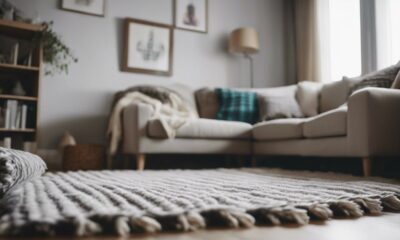
 Decorative Throws1 month ago
Decorative Throws1 month agoCan I Use a Throw Blanket as a Rug
-

 Decorative Throws1 month ago
Decorative Throws1 month agoWhat Wattage Is an Electric Throw
-

 Craft and Textiles1 month ago
Craft and Textiles1 month ago15 Best Battery-Powered Leaf Blowers for Effortless Yard Work
-

 Craft and Textiles1 month ago
Craft and Textiles1 month ago15 Best Cordless Mowers for Effortless Lawn Care – Top Picks of 2024
-

 Tableware and Dining Accessories1 month ago
Tableware and Dining Accessories1 month agoWhat Is the Meaning of the Word Tableware



















